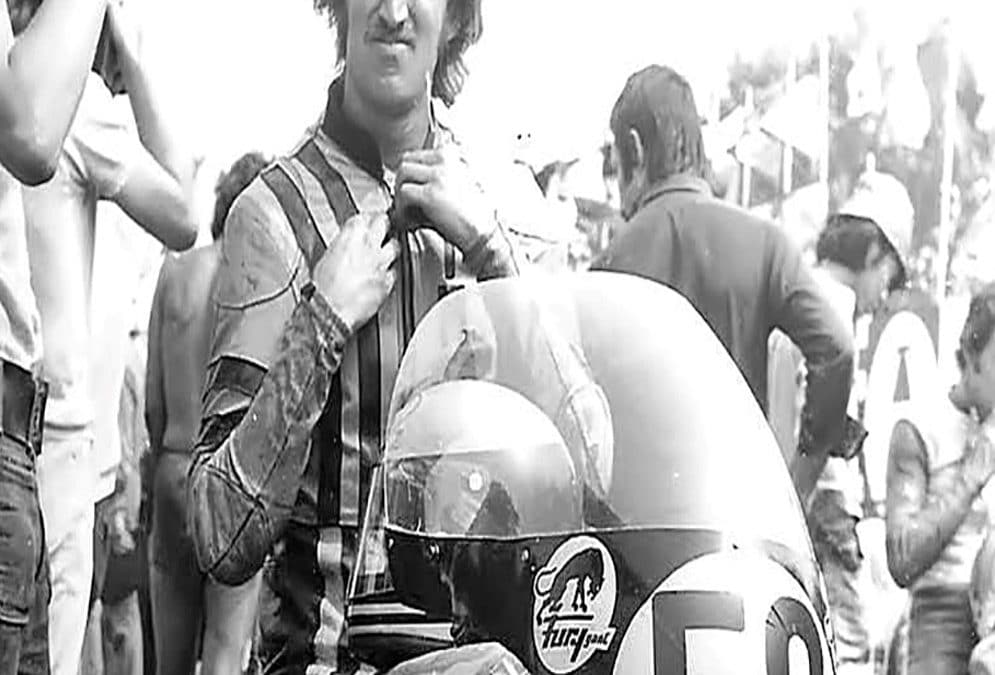Date of Birth 2 January 1944 – Date of Death 14 August 1973
Kim Newcombe was born in Nelson, but grew up in Auckland. An accomplished off road rider he finished second in the New Zealand 250cc Scramble Championship in the 1961/62 season in Tauranga on his Greeves Motorcycle.
In 1963, a nineteen year old Kim and wife Janeen moved to Australia where he worked as a mechanic as well as racing off road and speedway. In 1968, Kim was offered a job in Europe with the Maico Motorcycle Factory. Seeing it as a good chance to advance his motocross career they decided to head to Europe .However the job was not immediately available.
So rather, than wait around in Australia, he and Janeen headed for Germany anyway.
Being a mechanic and engineer Kim had some experience and success preparing and racing hydroplanes in Australia. He secured a short-term job with the two-stroke engine manufacturer Konig in Berlin. Konig was a leading hydroplane engine maker.
Kim was very familiar with the Konig engine, a 494cc flat four two stroke. The idea of a racing Konig powered motorcycle did not originally come from Kim.
When he arrived at Konig, there was already a bike with a Konig motor shoehorned in to an old BSA frame. The bike had been built by a German rider, but the projected was abandoned after he was badly injured on it.
Konig boss Dieter Konig was still convinced it would be possible to build a competitive racer. Kim agreed, so took over the project. The job offer from Maico was forgotten about. Kim jumped at the chance at developing the bike, and it was soon ready to debut. Fixing the overheating problems of the flat four, he then fitted a Norton clutch housing and a six-speed gearbox.
An accomplished off road racer, Kim had absolutely no road racing experience. That didn’t put him off. Securing a German national licence, he gave the bike a victory in its first race in Berlin. The next step was to develop the chassis.
For the 1971 Australian John Dodds signed up to ride the Konig in the 500cc World Championship. After a disappointing season of non-finishes, he left Konig.
Kim secured an international licence in 1972, so then became the rider as well as the developer.
The first race in 1972 was at the fourteen-mile Nurburgring circuit, first time out was another success, a podium finish. He then followed that up with a top ten result at the French 500cc Grand Prix. Kim and the Konig were building a reputation especially in Germany.
For 1973, the Konig had a new frame, and more horsepower. Kim had his old Australian mate Rod Tingate as his mechanic, who he had convinced to join him and Janeen and son Mark as team Konig.
Up against the might of MV Agusta with riders Giacomo Agostini and Phil Read and the factory Yamaha, team who were returning to the series with a new 500cc inline four bike, which was to be ridden by the 1972 World 250 Champion Jarno Saarinen from Finland and Japan’s Hideo Kanaya.
Saarinen would be killed at Monza Italy racing in the 250 Grand Prix in May. Yamaha withdrew from the series for the rest of 1973.
Saarinen on the new Yamaha had won the first two races of the season in France and Austria. Kim took fifth at Paul Ricard in France, then broke through with a 3rdplace in Austria behind Saarinen and Agostini. Disappointment for Kim and the Konig followed with a non-finish in the German round at Hockenheim.
The next round for the Konig was Yugoslavia, held around a narrow street Circuit. Kim set the fastest lap, and won the race and took the lead in the World Championship.
The rest of the season saw Kim finish second in the Netherlands, fourth in Belgium, then DNF in Czechoslovakia, third in Sweden and fourth in Finland.
The consistency of Phil Read and the MV Agusta sealed the Championship before the last round in Spain.
Kim was then offered good start money in a non-championship race at Silverstone racing with a bored out 680cc Konig. After practice, Kim suggested to the Clerk of the Course that some hale bales be placed in front of the solid wooden wall on the outside of Stowe corner. After much debating The Clerk of the Course still refused.
In the race, Kim was leading for the first six laps before hitting the dip at Stowe, running wide off the track and striking the wall.
He was treated at the track, but he never regained consciousness. He died on August 14 1973 in Hospital.
Kim was posthumously awarded second place in the 1973 500cc World Championship, behind Read, but ahead of Agostini.
This made him the third Kiwi in four years to finish second in the World 500cc Championship. Fellow MNZ Hall of Famer Ginger Molloy finished second in 1970 and Keith Turner finished 2nd in 1971.
It was only a dozen years from racing and fettling his Greeves and finishing second in the New Zealand 250cc Scramble Championship to finishing second in the World 500cc Road Race Championship on a motorcycle he built and developed. A truly remarkable achievement and deserving inductee to the MNZ Hall of Fame.
Kim’s short but brilliant road race career was told on film in 2007, with the
Documentary ‘Love, Speed and Loss’. Kim’s wife Janeen and son Mark
appeared in the film. Janeen passed away after the film was completed from Cancer. The film is available to watch online through nzonscreen.com.
Written for the MNZ Hall of Fame
By Ian Dawson 2021
